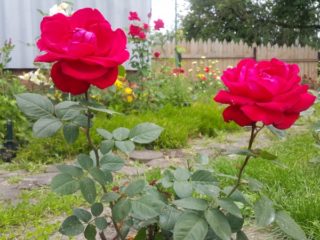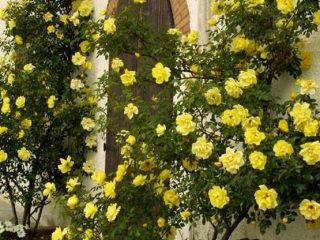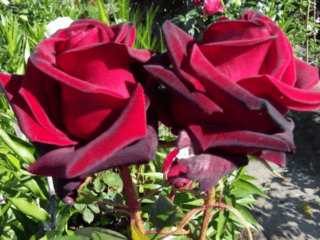Content
Among all garden specimens of this flower, English roses have always been distinguished by their harmonious shape, more lush and longer flowering, and resistance to many diseases. And these are the qualities that Lady Emma Hamilton has. Despite the fact that the Lady Emma Hamilton rose appeared relatively recently, she still managed to win the hearts of many gardeners.
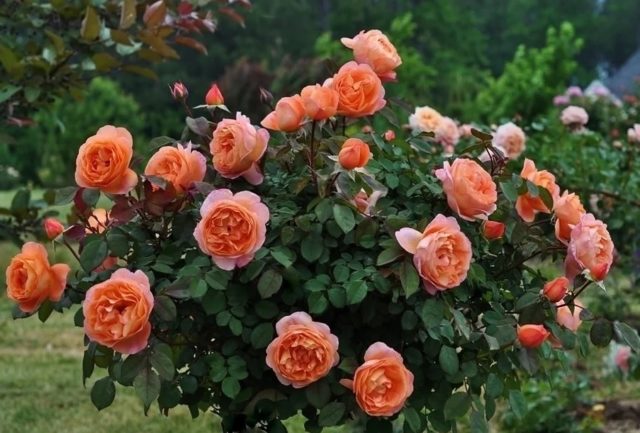
Rose Lady Emma Hamilton is today valued throughout the world due to its unpretentiousness and beauty.
History of selection
The Lady Emma Hamilton variety was bred in 2005 by the famous breeder David Austin, who is the creator of an unusual open-air nursery. The rose was named in honor of the beautiful beloved of Admiral Nelson. It can also be found under the name Ausbrother.
Just 2 years later, the variety was introduced in America, where it was rightfully appreciated by avid flower growers. And in 2010, the Lady Emma Hamilton rose was awarded 2 awards at once (Nagaoka Rose Trials and Nantes Rose Trials).In addition, the variety is a winner of the Prix International award for its unique and very pleasant aroma.
Description and characteristics of the rose variety Lady Emma Hamilton
Rose Lady Emma Hamilton is a fast-growing garden crop. It is assigned to the class of scrubs and hybrids of musk roses of English selection. It is a low bush plant, not exceeding 1.5 m in height. The shoots are erect and quite powerful. The width of the crown can reach 90 cm. There is a moderate amount of green mass. The leaf blades are matte, with a bronze tint, and medium in size.
The main feature of the variety, which also distinguishes it from classic English crops, is the unusual color of the flowers. When unopened, the buds have a reddish tint with small orange splashes, and in the full bloom phase the petals acquire a pleasant orange color with a pink tint.
The flowers themselves are large, up to 12 cm in diameter, cup-shaped, with a terry surface. The number of petals sometimes reaches 45 pieces. The inflorescences are quite fragrant, in the form of a brush of 3-5 buds. The flowers have a fruity scent, with notes of grape, pear and citrus.
The Lady Emma Hamilton rose blooms from June to September, however, this occurs in waves throughout the entire period. The most abundant flowering is precisely the first wave, and then the intensity decreases, but this does not in any way affect the decorativeness of the garden plant.
In addition to the unusual color of the flowers, the Lady Emma Hamilton rose also boasts high resistance to sub-zero temperatures. The culture is not afraid of winter frosts down to -29 °C. In addition, it easily tolerates dry weather.
Advantages and disadvantages
Rose Lady Emma Hamilton, based on her description and photo, can easily be called one of the most beautiful. Moreover, all the positive qualities of this variety successfully cover its few disadvantages.

The bud in appearance resembles a rather large ball
Pros:
- abundant and long flowering throughout the season;
- very beautiful flower shape;
- unique fruity aroma;
- unusual color of buds before and after blooming;
- ease of care;
- suitable for cutting cultivation;
- increased frost resistance;
- easy tolerance of dry weather;
- good immunity to diseases.
Minuses:
- stops blooming if the summer is cold and rainy;
- high cost of seedlings.
Reproduction methods
It is preferable to propagate the Lady Emma Hamilton rose in 2 ways:
- cuttings;
- grafting.
It is these methods that make it possible to preserve all varietal characteristics of a crop. In addition, a plant grown by any of these methods acquires quite strong immunity to various diseases.
For cuttings, young shoots are used, which are cut from the mother bush and divided into parts 10 cm long. Each piece should have at least 2-3 buds.
Above the upper bud, the cut is made straight, and under the lower bud, at an angle. Then the cuttings are dipped into a solution of growth stimulants for a day, after which they are transferred to the prepared substrate. Cover with film and leave for six months (during this time, be sure to ventilate and water the cutting so that it takes root).After rooting, you can plant it in open ground; the optimal time for this is mid-spring or early autumn.
Grafting rose Lady Emma Hamilton is performed in summer or autumn. Cuttings are also prepared for this. A T-shaped cut is made on the root collar of the plant and wiped. Then a bud with part of the bark underneath is cut off from the cutting. The workpiece is connected to the rootstock, fixed with film and sprinkled with earth.
Growing and care
It is recommended to plant seedlings of the Lady Emma Hamilton rose in a permanent place, taking into account the fact that the delicate petals are afraid of direct sunlight. Therefore, the site should be selected in partial shade. It is also advisable to give preference to an elevated place to prevent stagnation of water.
The planting hole must be at least 60 cm in diameter and the same depth. In this case, a drainage layer of 10 cm must be provided. The seedling itself is placed in the center of the hole and sprinkled with fertile soil. Lightly tamp and water generously.

In the first year, only in August you can leave a few buds, this will help stimulate the growth of the bush
As a follow-up care for this rose, the most standard actions are required:
- timely watering;
- loosening and removing weeds;
- feeding;
- pruning;
- preparation for winter.
The Lady Emma Hamilton rose should be watered at least once every 10 days. Carry out this procedure early in the morning or in the evening. Warm and settled water is used. And after watering, the soil in the root zone is loosened, removing all weeds if possible.
It is necessary to enrich the soil for roses 2-3 times per season.Spring and summer feeding is mandatory. In the autumn, you don’t have to do it. In early spring, the plant needs nitrogen and organic fertilizers, and during the summer the bush can be fed with potassium-phosphorus compounds.
Pruning plays an important role for the Lady Emma Hamilton rose, as this procedure allows you to form a beautiful crown and also contribute to abundant flowering. In the spring, the bush is freed from dead, dry and damaged branches, and in the fall - from faded buds. In this case, pruning is carried out by no more than 1/3 of the branch.
Despite its resistance to low temperatures, experienced gardeners still recommend insulating the Lady Emma Hamilton rose for the winter. To do this, the base of the bush is sprinkled with peat or soil, and then covered with non-woven material or spruce branches.
Pests and diseases
Rose Lady Emma Hamilton has strong immunity to many diseases. The health of a plant can only be harmed by improper care or planting too close. For example, overwatering can lead to powdery mildew or root rot.
As for pests, aphids and spider mites can be considered dangerous. To prevent the appearance of these insects, it is recommended to use a soap solution, and in case of severe damage, treat with insecticides.
English rose Lady Emma Hamilton in landscape design
The use of the Lady Emma Hamilton rose in landscape design has an endless number of options. This garden plant will look elegant both when planted alone and in combination with other crops.
This variety of rose harmonizes perfectly with cereals and bulbous crops and looks good against the backdrop of tall herbaceous plants. It can be used to decorate the area near a gazebo, bench, or entrance to a living space.
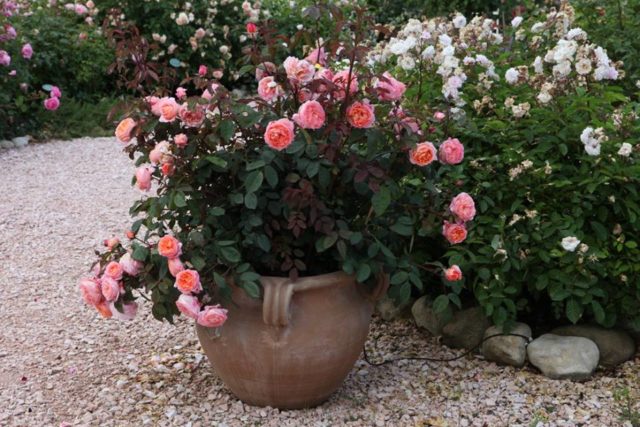
Experienced designers use the Lady Emma Hamilton variety when decorating their garden plots, creating unique compositions.
The rose is used as a tapeworm against the background of a green lawn. A perennial shrub with beautiful orange flowers can often be found in parks and rose gardens.
Conclusion
Rose Lady Emma Hamilton, bred by David Austin, will truly adorn any garden plot. In addition, this variety can be grown not only in open ground, but also in flowerpots and containers on the veranda or balcony.


